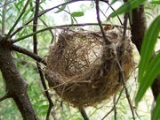
Nest
Overview
A nest is a place of refuge to hold an animal's egg
s or provide a place to live or raise offspring. They are usually made of some organic
material such as twig
s, grass
, and leaves
; or may simply be a depression in the ground, or a hole in a tree, rock or building. Human-made materials, such as string, plastic, cloth, hair or paper, may be used.
Generally each species has a distinctive style of nest.
Egg (biology)
An egg is an organic vessel in which an embryo first begins to develop. In most birds, reptiles, insects, molluscs, fish, and monotremes, an egg is the zygote, resulting from fertilization of the ovum, which is expelled from the body and permitted to develop outside the body until the developing...
s or provide a place to live or raise offspring. They are usually made of some organic
Life
Life is a characteristic that distinguishes objects that have signaling and self-sustaining processes from those that do not, either because such functions have ceased , or else because they lack such functions and are classified as inanimate...
material such as twig
Twig
A twig is a small thin terminal branch of a woody plant. Twigs are critically important in identification of trees, shrubs and vines, especially in wintertime. The buds on the twig are an important diagnostic characteristic, as are the abscission scars where the leaves have fallen away...
s, grass
Grass
Grasses, or more technically graminoids, are monocotyledonous, usually herbaceous plants with narrow leaves growing from the base. They include the "true grasses", of the Poaceae family, as well as the sedges and the rushes . The true grasses include cereals, bamboo and the grasses of lawns ...
, and leaves
Leaf
A leaf is an organ of a vascular plant, as defined in botanical terms, and in particular in plant morphology. Foliage is a mass noun that refers to leaves as a feature of plants....
; or may simply be a depression in the ground, or a hole in a tree, rock or building. Human-made materials, such as string, plastic, cloth, hair or paper, may be used.
Generally each species has a distinctive style of nest.
Discussions

